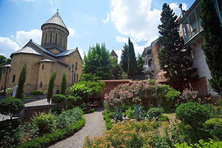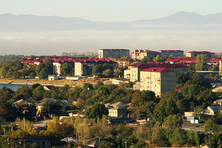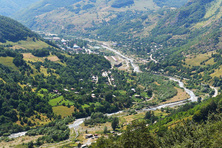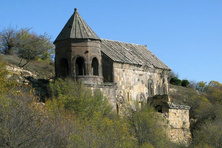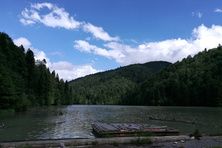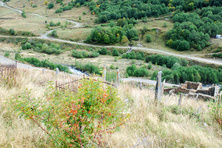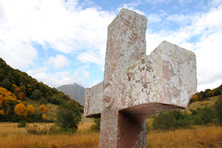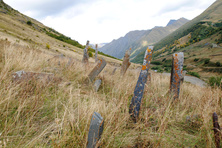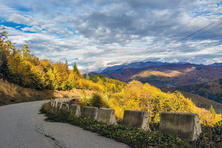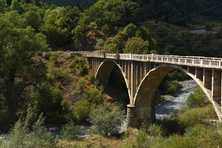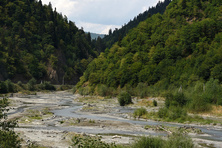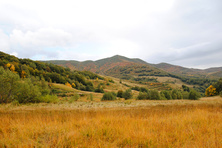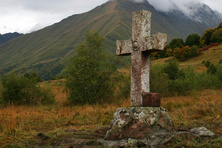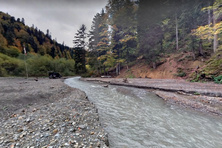South Ossetia
- Currency: Russian ruble
- Time: UTC+3
- Languages: Ossetian, Russian, Georgian
- Religions: Christianity (Orthodoxy)
- Sections: Get in Visa Customs Cuisine Money Details of interest Popular resorts
South Ossetia or the Republic of South Ossetia is an independent partly recognised state. The Constitution of Georgia is applied here. The country occupies the Greater Caucasus Mountain and hill districts of the Kartalin Valley. It borders Russia and Georgia. The capital city is Tskhinvali.
The country can be divided into 4 major climatic zones. On the south, the dry steppe climate is predominant. The districts in the Greater Caucasus Mountain are under control of wet high mountain climate. In the mountain regions, the climate is temperate wet and cold wet depending on the altitude. At high altitudes the snow does not melt and it attracts the lovers of extreme tourism, snowboarding, and skiing.
The official languages are Ossetian, Georgian, and Russia. The majority of the population are the orthodox Christians.
South Ossetia is a good destination for a well-being tourism due to its mineral sources. To improve your health go to Java. Some other popular spa resorts are Bagiata and Kodibin, hydropathic establishment Nagutni, and Codebin resort.
The lovers of ethnography should take a trip to the villages Croze, Cobett, Gufta, and Metekhi.
As there are not so many regular festivals, event tourism is not popular in South Ossetia.
Ecological tourists will enjoy the lakes and the rivers, they can go hiking to the high mountain forests in the Liakhvi Nature Reserve and see the Lake Arco.
The tourists who anticipate good shopping will be disappointed. There are not large shops or mall even in large cities. On the markets, one can buy some souvenirs and basic necessities.
The tourists choose South Ossetia to explore the local historical and architectural monuments. There are old cathedrals on the territory of the country. If you love excursions go to Leningor, Armazi, and the capital city.
Get in
By Land
As there are no airports in the country, the railway is not working, and the border with Georgia is closed the only way to get to South Ossetia is by public transport or by car from Russia.
There are buses running from Vladikavkaz to Tskhinvali. The Trans-Caucasus Motorway is the one highway linking South Ossetia with the Russian Federation. In winter, it is commonly closed due to avalanches.
Visa
The CIS citizens do not need a visa to travel to South Ossetia. The Russians can cross the border having the passport of the Russian Federation and all the rest must have an international passport.
The residents of the European Union must inform the Ministry of Foreign Affairs of South Ossetia about the intention to visit the country, at least, 3 days in advance. They can do it online on the website of the Ministry. The e-mail from the Ministry is a document permitting the entry to South Ossetia.
The EU tourists will need a multiple-entry, a double-entry or a transit visa to cross the border of South Ossetia from Russia. It is necessary to submit the documents to the Consulate. It usually takes 4 to 20 working days to obtain a visa. The Russian Federation law allows issuing an urgent visa within 1-3 days.
Customs
The Customs legislation of South Ossetia does not limit the import of currency. If the sum exceeds 10.000 US dollars, it must be declared. The same rules are applied to the export of currency.
The tourists are allowed to bring in the following goods duty-free:
- personal clothes, jewellery, accessories;
- photo and video gadgets;
- 5 kg of unpacked foods of animal origin;
- some alcohol and tobacco.
The total cost of imported goods must not exceed 1.500 Euros and the permissible weight is 50 kg.
It is not allowed to import:
- rare plants and animals and products made of them;
- poppy seeds;
- undeclared precious metals and gems;
- not certified fruits and vegetables.
The Customs legislation prohibits the export of:
- rare artefacts and antiquities;
- precious metals the total cost of which exceeds 25.000 US dollars;
- art objects;
- plants and animals protected by the State.
Cuisine
The cooking traditions of South Ossetia were greatly influenced by the ancestors of the Ossetians who led a nomadic way of life. Besides, in the high mountains fruits and vegetables do not grow. So the South Ossetian cuisine cannot boast of the variety of ingredients. However, unique traditional dishes attract the foodies to this country.
The staple food here is meat, oat, milk and dairy products. The major national dishes are boiled meat served with sour cream sauce and pies Chiritae with potato, cheese, meat or wild leek filling.
Like in all the countries of the Caucasus Region, kebabs are very popular in Ossetia. They call it Fizonaeg here. It is prepared from mutton or pork. The tourists should try a pie with beef liver Fydchin. No celebration is complete without it.
A typical side dish is Dzaerna with boiled corn and beans and Dzykka, a cheese and flour porridge. Cheese is an essential ingredient in the South Ossetian cuisine.
Different sauces also play an important role in the traditional cuisine. The most popular are Tsyvzy-tsaehdon with boiled peppers and sour cream and creamy garlic Nury-tsaehdon.
Do not leave South Ossetia without trying home-made flatbread Kaerdzyntae.
A soup is a rare thong on the table of the South Ossetians. The exception is a thick soup Dzaehaera. It is made with maize flour, herbs, eggs, and greens.
Every dish is commonly served with bread or fruit kvas Kuymael. Do not miss a chance to try beer Baegaeny and a strong alcoholic drink Araka. The locally produced wines are popular among the tourists.
Money
The official currency in South Ossetia is the Russian Ruble (RUB) which is divided into 100 kopecks. On the domestic market, they use the coins from 1 kopecks to 10 rubles and 10 to 5.000 ruble bank notes.
The tourists can exchange the currency in the office of the National Bank of the Republic of South Ossetia in Tskhinvali.
There are not ATMs or POS-terminals in hotels, restaurants or malls. The traveller’s checks are not accepted.
The situation is tense in the regions close to the Georgian border so avoid visiting them. Try not to go out without a local guide. To avoid the conflicts, do not contact with the local women.
Details of interest
Sightseeing in South Ossetia
There are no UNESCO sites in the Republic. The tourists can see the historical and architectural monuments that were preserved in South Ossetia.
To the north from the Goyata Village, there is the Ikortsky Temple. The dome temple was built in 1172; its facade is decorated with the ornaments and decorative arches laid over the surface of the walls.
The majority of the architectural monuments are in the capital city. It will be interesting to visit the Church of Saint Nicholaus built in the 19th century. In Tskhinvali, you can see the Church of the Assumption and the Nativity of the Virgin Mary Church. The Zguderskaya Church of Saint George was partially destroyed during the war.
Take a walk across the famous Jewish Quarter in the capital city. This large city district is known for its winding streets and merchants’ houses.
Not far from Tskhinvali, there is the Monastery of Tyre built in the 12th century. On its territory, you can see the bell tower and the refectory. The walls of the buildings are decorated with stone carving. Near the Monastery Complex, the tourists can see the old rock temples.
The main destination for the ecological tourism is the Liakhvi Nature Reserve. Its territory is covered with high mountain forests. Extreme tourists like the local gorges and the most popular is the Gnuhskoe Gorge.
Anyone can take a walk along the coast of the Lake Ertso in the Kudarskoe Gorge. Not far from it, there is the Ertso Village where you can learn more about the everyday life of the locals.
Souvenirs in South Ossetia
The tourists can buy gifts and souvenirs to remember their journey to this country:
- decor items made by the local craftsmen;
- souvenirs with traditional symbols;
- dolls in the national costumes;
- kindjals and sword-blades;
- authentic jewellery.








